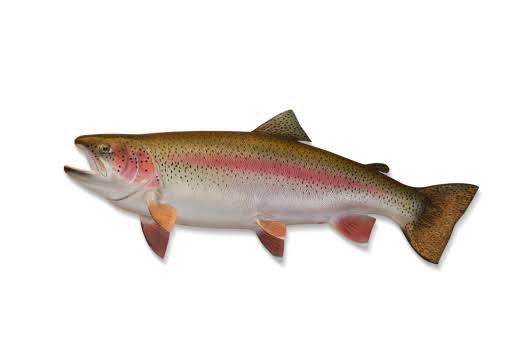Breeding of trouts
8.1. Introduction
- Trouts belong to the family Salmonidae and Order Salmoniformes
- Among trouts, the rainbow trout, Oncorhynchus mykiss, is
the most important species.
- Other species of trouts are : brown trout (Salmo trutta fario),
brook trout (Salvelinus fontinalis), lake trout (Salvelinus
namaycush), etc.
Trouts native to India are : snow trouts (Schizothorax spp.)
8.2. Habitat and biology of rainbow
trout
- The rainbow trout (RBT) is native to North
America.
- Since 1874, the RBT has been introduced into
several Continents, except Antarctica. It is farmed in about 64 countries.
- It is a hardy fish,
- Easy to spawn
- Fast-growing, reaching 5-10 kg in 3 years,
with anadromous (steelhead trout) growing faster (7-10 kg)
- Tolerant to a wide range of environments and
handling
- Large-scale fry production is possible as they
prefer to feed on zooplankton
- It is anadromous as well as purely river or
lake resident (spends entire life in river or lake)
- Can tolerate temperature of 0-27oC,
spawning and growth occur at 9-14oC.
Identifying characters
- Trouts have fusiform body with 60-66
vertebrae, 3-4 dorsal spines, 10-12 dorsal soft rays, 3-4 anal spines,
8-12 anal soft rays, 19 caudal rays.
- Adipose fin present, usually with black edge.
- Coloration blue to olive green above a pink
band along the lateral line and silvery below.
Food and feeding
- Adults feed on aquatic and terrestrial
insects, molluscs, crustaceans, fish eggs, minnows and small fishes.
- Juveniles are omnivorous.
- Freshwater shrimps when fed to trouts supply
carotenoid pigments which imparts orange color.
8.3. Brood-stock development
- RBT spawn during spring (January-May), but photoperiodic
manipulation can advance or delay maturation and spawning which ensures
year-round fry production.
- It does not spawn naturally captivity and in aquaculture systems.
- Eggs are artificially obtained by spawning or stripping females.
- Ripe/fully mature females (3-4 year-old) fish is preferred.
- High quality broodstock is used.
- More number of females is required as fecundity is low.
- Females produce up to 2,000 eggs /kg body weight.
- Eggs are large (3-7 mm)
- Sex ratio 1 : 3 (male and female) are kept separately prior to
spawning.
- Since broodstock development is costly, eggs are seldom purchased
and hatched.
- Disease-free eggs are purchased. But they should be treated with
iodine at 100 mg/l for 10 minutes.
- All-female triploid (sterile) trout produced through gynogenesis
and triploidy and all-female progeny produced through 17α - MT treatment
and selective breeding are also used for grow-out farming.
8.4. Stripping and fertilization
- Sex of broodfish is identified based on secondary sexual
characteristics which are more pronounced during breeding season.
- Females are slightly larger and have swollen abdomen
- Males are slightly smaller and have round abdomen
- Stripping and fertilization technique is well-developed
- Dry method of fertilization is a common approach
- No hormones are used for spawning in this species.
- Eggs are stripped on to a clean basin and mixed with milt from more
than one male to ensure better fertilization and reduce inbreeding.
- Fertilized can be transported after 20 minutes and up to 48 hours
after fertilization, but then not until the eyed-stage.
- Exposure of fertilized eggs to direct sunlight should be avoided.
8.5. Hatching
- Eggs incubated undisturbed until the
eyed-stage, in hatching troughs, vertical incubators or hatching jars.
- Hatching and rearing troughs are 40-50 cm
wide, 20 cm deep and up to 4 m in length.
- Two layers of eggs are placed in wire baskets
or screened trays.
- Water flow rate is 3-4 l/minute.
- As the eggs hatch, the fry drop through the
mesh to a bottom trough.
- Some times up to 16 trays are stacked one
above the other.
- Hatching period is 100 days at 3.90C
or 21 days at 14.40C.
- Dead eggs are periodically removed to limit
fungal attack.
- Fugal infection is controlled using formalin
(37% solution of formaldehyde) for 15 minutes.
- Hatching rate is up to 95%.
- Yolk-sac absorption period lasts for 2-4
weeks.
- After hatching, the trays are removed and
trough water depth is maintained at 8-10 cm until swim-up stage
- After yolk-sac absorption, the fry actively
actively search for feed.
Developing
Trout eggs
8.6. Fry rearing
- Fry are traditionally reared in fiberglass
concrete tanks (circular ones preferred).
- Diameter of circular tank is 2 m or size of
squarish tank is 2 m x 2 m, with 50-60 cm depth.
- The drain is fixed in the centre of the tank
and is protected by a mesh screen.
- Fry are fed with specially prepared starter
feeds using automatic feeders.
- Feeding rate is 10% b.w. daily for 2-3 weeks
using continuous feeders
- Feed pellets contain fish meal (80%), fish oil
and grains.
- Feed contains proteins (50%), fat (12-15%) and
vitamins (A, D and E), minerals and pigments (astaxanthin and
canthaxanthin).
Water quality
requirements
DO : near saturation
CO2 :
< 2 ppm
Temperature : 12-210C
pH : 6.5-8.5
Alkalinity : 10-400
ppm (as CaCO3)








0 Comments